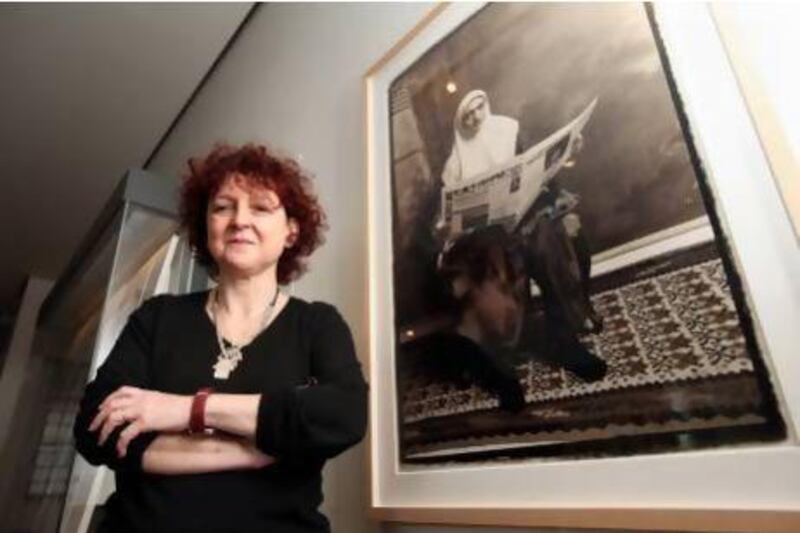With almost 150 galleries in Dubai and an explosion of interest in Middle Eastern art around the world, there's never been a better time to invest in a piece, whether it's something pretty for above the sofa or the start of a serious collection.
At the Aga Khan University Institute for the Study of Muslim Civilisations in London on Saturday, three experts will speak on the subject: the British Museum curator Venetia Porter, Mirjam Shatanawi from the Tropenmuseum in Amsterdam and Janet Rady, a London-based dealer specialising in Middle Eastern art. Here's a sneak peek at their art-buying advice.
Trust your gut
"You need to fall in love with the work," says Porter. There's no such thing as a sure-fire investment, and you shouldn't listen when people say that they're certain an emerging artist is going to be huge. However, as Rady says: "If you love [a piece], chances are someone else is going to love it and chances are if they love it, then you'll be able to sell it."
Study technique
While taste is subjective, technical ability is a fact. An artist can either draw or she can't: if you don't have a trained eye, consult someone who does.
Look for a story
Narrative is important to museum collectors such as Porter and Shatanawi and it can be important to private collectors, too. Is the piece a reaction to the Tahrir Square uprisings, made soon afterwards by a Cairo artist? If so, it could be a piece of history. "If the work has a message," Rady says, "it should be relevant to its time."
Seek originality
An artist's worth will plummet if she starts repeating herself; similarly, a market with too many paintings of women in veils will become oversaturated. Calligraphy is a recurring motif in Middle Eastern art - some might say it's a safe bet - but don't be afraid to buy a bold abstract piece or something that doesn't address specifically Arab or Islamic topics. Good art can be about anything.
Find untapped artistic communities
The not-for-profit Edge of Arabia initiative single-handedly created a market for Saudi art, Shatanawi says. The Iranian art market is well-established, but curators are currently looking towards Azerbaijan and Kazakhstan, according to Rady, where undiscovered talent abounds. Artists from Libya and Iraq, Shatanawi says, have yet to be promoted.
Watch the news
The more a country is mentioned in the press, the better its art will sell. The spotlight is currently on Syrian and Egyptian artists, who are the focus of exhibitions looking at the effect of the Arab Spring on contemporary art.
Check for authenticity
If you buy from a big auction house, this will have been certified, but if you're spending serious money, you can double check it's not stolen through the Art Loss Register (www.artloss.com/en). Provenance can be important, if you're shopping in the secondary market.
Talk to experts
If you're buying through a gallery, Rady says, ask to see the work before the private view opens. Alternatively, go to an art fair on the first two days, when big-shot gallery owners will be at their stalls. While you'd be laughed at if you walked into the Gagosian Gallery in London and asked to speak to Mr Gagosian, she says, do the same thing at Frieze Art Fair in London and you may be in luck. But you have to let the experts know that you don't just want the hard sell; you want to learn.
Educate yourself
Regularly read exhibition catalogues from specialist galleries such as Rose Issa Projects in London, study art-collecting books and read magazines such as Canvas, Porter says. Shatanawi recommends websites such as Universes in Universe (www.universes-in-universe.org) and the Gulf Art Guide (gulfartguide.com).
Rady says that auction estimates can often be more telling than sales. Estimates are based on the expert opinions, while a sale can be swayed by chance factors such as galleries bidding a work up, another auction happening on the same day or big buyers simply having to leave early.
See the work in person
It's quick and easy to browse works online, via galleries including Rady's, but after you've found an artist you like, Shatanawi says, visit them, talk to them about their work and ask if they have any pieces you can look at that might not yet be on sale. "It's time-consuming," she says, "but you get better work."
A short course about collecting and exhibiting Middle Eastern art will take place at Aga Khan University on Saturday. The artist Zineb Sedira will also speak





